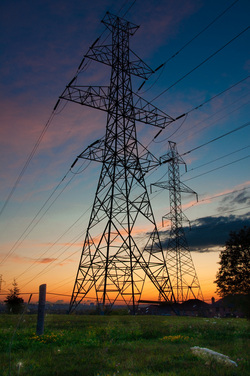 Listing requirements for less-flammable liquids
In discussing the requirements of various codes on the installation of transformers using less-flammable liquids, you'll encounter a requirement to comply with the listing of the liquid. Due to this requirement, it's important that you understand the various listing agency requirements for these units. In our discussion here, the use of the term "listing" or "listed" follows the basic definition from the National Electrical Code (NEC). This definition reads as follows:
Listed: Equipment or materials included in a list published by an organization acceptable to the authority having jurisdiction and concerned with product evaluation, that maintains periodic inspection of production of listed equipment or materials, and whose listing states either that the equipment or materials meets appropriate designated standards or has been tested and found suitable for use in a specified manner.
Less-flammable liquids are currently listed with Underwriters Laboratories (UL) and FM.
Factory Mutual. FM recommends certain practical and effective mechanical and electrical protection schemes for particular types of transformers. Fire protection is a base level of protection that FM requires for transformer installations that expose buildings or other property to potential damage. However, FM also gives consideration to omitting fire protection if the transformer installed is a less-flammable type with proper electrical and mechanical protection and if it is not installed as a network transformer.
Protection systems should be determined by an engineering study that considers the criticality of the supplied loads and the level of fire exposure that may be presented by a transformer failure. Various schemes of electrical protection can be employed from normal overcurrent protection to the inclusion of differential relays, ground relays, etc. FM's guidelines give varying degrees of overcurrent protection required based upon the transformer kVA and the supply configuration.
Per FM, all indoor transformers should be installed at least 3 ft from building walls, and containment systems should be provided for the transformer liquid in case of tank rupture. The containment area should be capable of containing the liquid from the largest transformer located within the space.
For transformers that are FM approved, the following elements are required in order to install the transformer without additional fire protection:
* Tank design strength to prevent tank rupture under low energy fault conditions;
* A pressure relief device to relieve pressure if a low current fault occurs until it can be cleared by the electrical protection;
* Electrical protection in the form of a ground fault relay, sudden pressure relay, or other device of equivalent reliability to clear sustained low current faults;
* A liquid with a firepoint greater than 300 [degrees] C; and
* Electrical protection to clear high current faults. This protection is based on the liquid volume of the transformer and is intended to electrically isolate the transformer [TABULAR DATA FOR TABLE 2 OMITTED] rapidly enough to prevent pressure increase to greater than half the tank burst pressure.
If the transformer is used on a network system, FM also requires that the transformer be installed in a room with a 3-hr construction or a room with 1-hr protection and automatic sprinkler protection.
For transformers installed outdoors, you must give some additional considerations to their location based on the insulating liquid used. In general, FM requires that they meet the above items outlined for indoor transformers and, in addition, the building should be protected by separation, fire barriers, or a water spray system.
The separation distances are shown in Table 1 (on page 80). These values show the varying degrees of separation needed between a transformer and an adjacent building. The distances increase depending on the fire hazard introduced by the volume of liquid in the transformer and the liquid type.
If the separation shown in Table 1 cannot be maintained, a fire barrier should be provided to protect the building from exposure to the fire. Fabricated barriers should be constructed of concrete block or reinforced concrete construction with a 2-hr fire rating. This barrier should extend beyond the transformer by the horizontal or vertical distances shown in Table 1.
If a building wall is used as the fire barrier, the exposed wall should be fire-resistive or noncombustible construction for transformers with less than 500-gal fluid capacity. For transformers with more than 500-gal capacity, the building wall should be of 2-hr fire resistance. In all cases, the wall should extend the horizontal and vertical distances specified in Table 1 from the transformer.
A water spray system may be provided for additional protection provided it has a discharge density of .20 gal/min over the exposed surface.
UL listing requirements
Significant revisions in the Factory Mutual Transformer Loss Prevention document in October, 1994 resulted in FM adopting a protection scheme similar to the original UL requirements. FM dropped requirements based on heat release rate and incorporated protection against tank rupture. Now, both UL and FM use mechanical and electrical protection combined with the good fire-resistance properties of less-flammable fluids to prevent transformer tank rupture, explosion, and fire. There have been no reported eventful failures involving less-flammable units with these requirements. Similar protective devices (with the addition of low current fault protection) are also used by FM for its new FMRC-Approved Transformer standard.
Presently, UL has classified only two liquids in the less-flammable category: a high molecular weight hydrocarbon (HMWH) and a silicone. Common to both classifications are the following additional use restrictions:
* They are applicable to 3-phase transformers only;
* The transformer tank must be able to withstand an internal pressure of 12 psig;
* The transformer must be equipped with a pressure relief valve with a capacity based on the transformer kVA rating;
* The transformer primary side over-current protection must be selected to meet specific energy let-through ([I.sup.2]t) specified in the use restrictions; and
In mid-1995, a revision in both UL less-flammable fluid classifications banned the use of immersed expulsion fuses that vented during operation, unless the classified fluids are tested effectively and the installation includes primarily current limiting fusing. A representative classification marking is shown in Table 2 for a specific silicone brand. In December of 1995, UL tested and reversed the internal expulsion fuse ban for an HMWH fluid classification. The resulting UL marking is shown in Table 3.
The requirement noted above takes into account the fact that many transformer designs have the primary fusing in the transformer case, under the same insulating fluid as the transformer itself. The UL-classified HMWH fluid allows the additional option of current limiting fusing (which may be used alone or in combination with under-oil expulsion fuses inside the transformer tank), or the option of external expulsion fusing without current limiting fusing, provided the let-through current/time is within the maximum allowable limit
End
(by Loyd, Richard E)
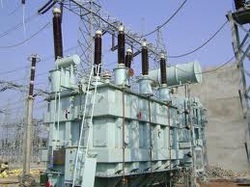 Transformer modifications
Sec. 450-28 of the NEC has some specific provisions that govern modifications to transformer installations. Although the NEC is not a retroactive document, it is specific in establishing requirements where a modification can change the entire context of a particular installation. Transformers are an excellent example of this case.
When modifications are made to a transformer that changes its type (i.e. oil-insulated to less flammable), it must comply with the appropriate requirements for the installation of the new type. The transformer must be marked to show the type of insulating liquid used in the modification. This marking is a critical element for an inspector to determine if the transformer is in compliance with its appropriate installation requirements.
This requirement for a marking and compliance with the installation requirements for the new "type" can work to a user's advantage as well. If buildings are expanded or altered such that they no longer have appropriate distance separation from, for instance, an oil-insulated transformer, then the transformer may be modified with a less-flammable liquid, and the new space separation may now be acceptable.
Transformer installation requirements in the 1996 NEC
Some changes in the requirements for the installation of less-flammable liquid-filled transformers appear in the 1996 NEC. These changes are significant enough to warrant their consideration here.
The Code-Making Panel covering transformers received proposals for Sec. 450-23 to clarify the installation requirements in both indoor and outdoor locations for less-flammable liquid-filled transformers. Per Fig. 7, you can see that one of the permitted installation methods for less-flammable liquid-filled transformers is to comply with the requirements in Sec. 450-26. These requirements are written specifically around oil-filled transformers, and the panel made it clear that the less-flammable liquids are permitted to be installed in situations identical to that for oil-filled. The basic requirement in Sec. 450-26 is to install the transformer in a vault constructed in accordance with Part C of Art. 450, unless one of the following exceptions can be met.
* If the total transformer capacity is 112 1/2 kVA or less, the vault may be constructed of 4-in. reinforced concrete.
* If the nominal voltage is 600V or less, the vault may be omitted if arrangements are made to prevent a transformer oil fire from igniting other materials, and the total transformer capacity does not exceed 10kVA in a section of a building classified as combustible or 75kVA in a section classified as fire-resistant construction.
* Electric furnace transformers can be installed without a vault where the total rating does not exceed 75kVA, and arrangements are made to prevent a transformer oil fire from igniting other materials.
* Transformers are permitted to be installed in a detached building that does not comply with the vault requirements if neither the building nor its contents present a fire hazard to any other building or property, and if the building is used only in supplying electric service, and the interior is accessible only to qualified persons.
* The vault may be omitted for transformers used in portable and mobile mining equipment with additional conditions specified.
Outdoor locations
Since less-flammable liquids are indeed less of a fire safety hazard than their mineral-oil counterparts, the 1996 NEC clarifies installation requirements for outdoor installations as well.
For installations attached to, adjacent to, or on roofs of Type I or Type II buildings, the installation shall simply comply with all of the restrictions in the listing of the liquid. A fine print note in Sec. 450-23(b)(1) notes that when the transformer is installed adjacent to combustible materials, fire escapes, or door and window openings, additional safeguards may be necessary. The safeguards noted in Sec. 450-27 may be acceptable. Note that in the 1993 NEC, this was part of the actual requirement, and the current status as FPN makes continued enforceability questionable.
For other than Type I or Type II buildings, the installation shall be installed in accordance with the same requirements as oil-filled transformers in Sec. 450-27.
NESC requirements for less-flammable liquids
The NESC is published by the Institute of Electrical and Electronics Engineers (IEEE) as ANSI/IEEE C2-1993. The document generally is used by utility companies and provides practical safeguarding of persons during the installation, operation, or maintenance of electric supply and communications lines and their associated equipment. The NESC specifically references the NEC for building utilization wiring requirements.
As the following sections will show, the NESC has very few specific requirements for transformers. This should be considered along with the fact that most utilities have their own operating and installation procedures above and beyond any code or standards requirements.
Although enforcement of the NESC is by the utility companies themselves, engineers and inspectors outside of the utility industry should be aware of NESC requirements for transformers. Since the local authority having jurisdiction is primarily [TABULAR DATA FOR TABLE 1 OMITTED] concerned with fire and personnel safety within and around public or private buildings, the location of a transformer, even one owned and maintained by the utility, can become a concern if a building or combustible materials are in close proximity.
The NESC has specific transformer requirements for installations in "electric supply stations." It defines these areas as "any building, room, or separate space within which electric supply equipment is located and the interior of which is accessible, as a rule, only to qualified persons. This includes generating stations and substations, including their associated generator, storage battery, transformer, and switchgear rooms or enclosures, but does not include facilities such as pad-mounted equipment and installations in manholes and vaults."
Outdoor installations. The NESC has language that is much less specific than that provided in the NEC. Sec. 152(A) simply requires that specified methods be used to minimize fire hazards associated with liquid-filled transformers. These specified methods include the following:
* Use of less-flammable liquids;
* Space separation;
* Fire-resistant barriers;
* Automatic extinguishing systems;
* Absorption beds; or
* Enclosures
Although the specific requirements to apply these methods are not provided in the NESC, you should consider using some of the methods described in this document, particularly if the transformer is located close to a nonutility building.
Indoor installations. The NESC categorizes transformers located indoors as liquids of flammable, nonflammable, and less-flammable types. Transformers containing flammable liquids (such as mineral oil) and rated above 75kVA must be installed in ventilated rooms or vaults separated from the rest of the building by fire walls. The specific rating of the fire walls are not given in the NESC. As such, you should consider the degree of the fire hazard when determining the rating of these walls. Doorways leading to the room or vault should be constructed with a fire-resistant rating as well. It's also required that the room or vault have a means to contain the liquid of the transformer(s), should a rupture occur.
The NESC specifies that a pressure relief vent of a transformer with a nonbio-degradable liquid, when installed, be provided with a means for absorbing toxic gases. This requirement relates to that discussed in NEC Sec. 450-24 for these transformers.
Less-flammable liquid. NESC requires that less-flammable liquid-filled transformers be installed in a way to minimize fire hazards. You must consider the type of electrical protection, amount of liquid contained, and tank venting when selecting a location for the transformer.
(by Loyd, Richard E)
to be continue...
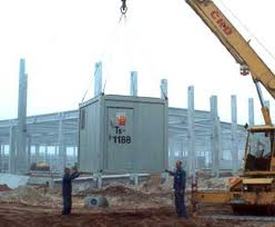 Outdoor transformer installations
The concern for fire hazards here is reduced because of the outdoor location; however, the hazard is not eliminated, and you must take the following precautions.
Less-flammable liquid-insulated transformers. The requirements for these installations can be found in Sec. 450-23. Transformers meeting the less-flammable class requirements can be installed outdoors attached to, adjacent to, or on the roof of Type I and Type II buildings, as shown in Fig. 3. (Type I and II building constructions are classified as noncombustible construction and can be further investigated in NFPA/ANS1220-1995, Types of Building Construction. Local building codes such as BOCA, ICBO, SBCCI, etc. also may influence the determination of building construction type.)
Less-flammable liquid-insulated transformers have requirements for additional safeguards if they are installed outdoors on, attached, or adjacent to buildings not meeting Type I or Type II constructions, or if they are adjacent to combustible materials. These additional safeguards are not clearly spelled out in the NEC, but some guidance is given. You should discuss this with the local authority having jurisdiction. Fire barriers, space separation, and compliance with the liquid listing requirements are all recognized safeguards in the NEC.
Fire barriers generally consist of 1-hr fire-rated materials and may be one-, two-, three-, or four-sided, depending upon the arrangements of the transformer to the occupancy. [ILLUSTRATION FOR FIGURE 4 OMITTED].
Space separation, as shown in Fig. 5, is a requirement based on the relative separation of the transformer from the building or combustible materials. To determine the proper space separation, you have to evaluate the amount of liquid and its particular heat-producing characteristics. Factor Mutual (FM) has performed such evaluations and provides recommended clearances for the various types of transformers.
Compliance with the liquid listing requirements: Basic details regarding the listing agency requirements are discussed later.
The NEC also requires that similar safeguards to the ones discussed above be taken if the transformer is located adjacent to fire escapes or door/window openings. The intent with this precaution is to ensure that adequate means of egress from the building is provided if the transformer is in a failure mode.
Sec. 450-24 covers this class of transformer for outdoors installations as well. No special requirements exist for these transformers installed outdoors. They must be designed and constructed to absorb any gases generated by arcing inside the tank, or the pressure relief vent must be vented to an environmentally safe area.
Oil-insulated transformers. Sec. 450-27 of the NEC is specifically dedicated to these transformers installed outdoors. The NEC does not provide any special requirements for these transformers if they are installed adjacent to, attached to, or on the roof of a building of noncombustible construction (except when installed close to doors, windows, or means of egress). However, good engineering judgment should be used when installing in these locations.
Oil-filled transformers can have failures resulting in a transformer fire, and the potential impact of that fire on the building should be evaluated. The heat convection and radiation rates of the oil should be reviewed and compared with the ability of the building construction to handle the heat released during a fire. Some guidance to this type of evaluation is provided in the "Listing Requirements" section of this article, on page 80. Also, you should reference IEEE 979-1992, Guide For Substation Fire Protection.
Additional information can be obtained from insurers for guidance. FM, for instance, gives a number of reasonable guidelines for these transformers where they are installed adjacent to a building.
For other situations, the NEC requires that "combustible materials, combustible buildings, parts of buildings, fire escapes, and door and window openings shall be safeguarded from fires originating in oil-insulated transformers installed on roofs, attached to, or adjacent to a building or combustible material."
The recognized safeguards, as shown in Fig. 6 (on page 79), are space separations, fire-resistant barriers, automatic water spray systems, and enclosures that confine the oil of a ruptured tank.
(by Loyd, Richard E)
to be continue...
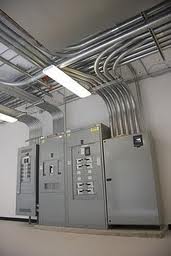 Indoor transformer installations
Transformers installed interior to a building require special consideration for their placement because of the potential hazard should a catastrophic failure occur. The objective of the following rules is the practical safeguarding of people and property.
Less-flammable liquid-insulated transformers. The specific NEC requirements for these transformers can be found in Sec. 450-23. Transformers qualifying for placement in this category must contain a liquid with a fire point not less than 300 [degrees] C. The flow chart in Fig. 1 (on page 75) describes an overview of the requirements for this section.
Nonflammable fluid-insulated transformers.The specific NEC requirements for these transformers can be found in Sec. 450-24. Transformers in this class must have a nonflammable dielectric fluid that does not have a flash or fire point and is not flammable in air. The flow chart in Fig. 2 describes the requirements for this section.
Askarel-insulated transformers. NEC requirements for these transformers can be found in Sec. 450-25. Transformers in this class are insulated with Askarel fluid. If the transformer is rated over 25 kVA, it must be provided with a pressure-relief vent. If installed in a poorly ventilated area, the transformer must be provided with a method to absorb any gases generated by arcing inside the case, or the pressure relief vent must be vented to the outside of the building.
As with less- and non flammable liquid-filled transformers, those filled with Askarel are not required to be installed in a vault unless rated greater than 35kV. The requirements in this section have remained unchanged for many years, since no new installations have been made in recent years.
Oil-insulated transformers. The specific NEC requirements for these transformers can be found in Sec. 450-26. In general, these transformers always must be installed in a vault. Exceptions to the vault requirements are as follows.
* If the total transformer capacity is 112 1/2kVA or less, the vault may be constructed of 4-in. reinforced concrete.
* If the nominal voltage is 600V or less, the vault may be omitted if arrangements are made to prevent a transformer oil fire from igniting other materials, and the total transformer capacity does not exceed 10kVA in a section of a building classified as combustible or 75kVA in a section of a building classified as fire-resistant construction.
* Electric furnace transformers can be installed without a vault where the total rating does not exceed 75kVA, and arrangements are made to prevent a transformer oil fire from igniting other materials. These transformers are very specific to applications involving electric furnaces, and since many precautions must be taken for the electric furnace itself, the vault requirement is relaxed.
* Transformers are permitted to be installed in a detached building that does not comply with the vault requirements if neither the building nor its contents presents a fire hazard to any other building or property, and if the building is used only in supplying electric service, and the interior is accessible only to qualified persons.
* The vault may be omitted for transformers used in portable and mobile mining equipment with additional conditions specified.
(by Loyd, Richard E)
to be continue...
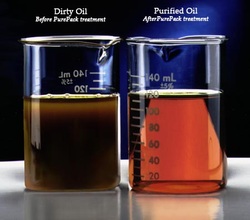 Knowing NEC, NESC, insurer, and listing agency installation requirements will help you select the best type of insulating medium for the application.
Increasing concerns over fire safety in and around buildings can result in questions about transformer installations, specifically for liquid-filled transformers. Also, installation requirements per the National Electrical Code (NEC) and the National Electrical Safety Code (NESC) as well as insurer and listing requirements can influence your decision as to the type of transformer specified. The following will answer these questions and help you make informed decisions.
A variety of requirements may be applied to a transformer installation, but each one must be considered for the application. We'll focus our attention on the following:
* The NEC (1993 and 1996 editions), which is generally enforced by local authorities responsible for building and/or electrical codes;
* Listing requirements, which are based on third-party evaluation of the transformer or components and are specific to the product and manufacturer;
* Insurer requirements, since the failure of a transformer can result in property damage, loss of life, and loss of revenue (due to downtime) for the business affected by the failure; and
* Local amendments, which the local code enforcing body may have adopted, additional requirements above and beyond the basic installation Code.
Transformer installation requirements in the 1993 NEC
In order to evaluate the specifics of NEC requirements on transformer installations, you should review the requirements for each transformer type. To show the differing requirements related to various transformer types, we'll cover the specifics for less-flammable liquid-, non flammable liquid-, Askarel-, and oil-filled transformers.
Vaults. In determining the type and location of a transformer in a design, the requirement to have a transformer vault plays a key role in the cost and safety of an indoor installation. The expected construction costs and space impacts of a vault must be considered before selecting the particular transformer to use. So that you can understand the magnitude of the vault issue, the following requirements for transformer vaults are summarized from Part C of Article 450 in the NEC.
Walls, roofs, and floors shall be constructed of materials providing a minimum fire resistance rating of 3 hrs. Typical of this rating is 6-in.-thick reinforced concrete.
Floors in contact with the earth shall be 4-in.-thick concrete minimum. If located with space below, the floor shall have structural strength for the expected load and have a fire resistance rating of 3 hrs.
Doorways leading to the interior of a building from the vault shall have a 3-hr construction. A door sill or curb must be provided that will confine the oil from the largest transformer within the vault. Minimum sill height is 4 in.
Doors shall be equipped with locks and accessible only to qualified personnel. Doors shall swing out and be equipped with panic bars, pressure plates, or other devices that are normally latched.
Ventilation (per specifics in Sec. 450-45): The vault must be ventilated to remove the heat generated by the transformers during operation so as not to create a temperature rise beyond the transformer rating.
Drainage: Vaults containing more than 100kVA of transformer capacity shall be provided with a drain or other means that will carry off any accumulation of oil or water in the vault unless local conditions make this impracticable. The floor shall be pitched to the drain where provided.
Note: If the transformer is protected with an automatic sprinkler, water spray, carbon dioxide, or halon, the entire vault construction is permitted to be of a 1-hr rating.
As you can see, there's a substantial investment in construction costs and physical space when a transformer vault is needed. However, by utilizing the following additional safeguards, a vault may not be necessary.
(by Loyd, Richard E)
to be continue...
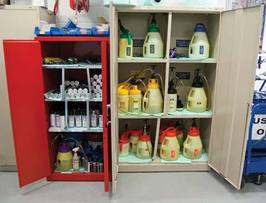 7. Precision Top-Ups and Drain and Fills
Once the bulk storage system is properly set up, one should consider the method for transporting oil and filling machines. The best top-up method utilizes a proper top-up container, one that is sealed from the environment, has a built in spout, hand pump, etc. If short cuts are taken at this stage, all of the time and effort spent building and designing the bulk storage system and ensuring the quality of the bulk oil with filtration will have been wasted. Too many times oil is highly contaminated from the time it is dispensed into the top-up container to the time it is added to the machine.
Using washable and re-usable top-up containers allow for easy cleaning and maintenance. Typically, non-sealable top-up containers that are re-used introduce large amounts of containments to the system, which could counteract any effort of removing or excluding contaminants, and also can have a slight lubricant cross-contamination effect.
For top-ups of larger sump volumes, such as large gearboxes, circulating system reservoirs, etc., the use of filter carts is the preferred method for transferring the new oil from the storage container to the machine.
8. Proper Top-Up Container and Grease Gun Storage
Storage for top-up containers, grease guns, rags, etc., is another important step to ensure contaminants are not introduced to the lubricants as a result of poor housekeeping. These tools should have their own dedicated fire-proof storage cabinets for easy access and organization.
Grease storage is simpler than oil storage but also must not go overlooked. Open grease tubes and drums are magnets for attracting airborne contaminants such as lint and dust. Securing used grease tubes that will be re-used in sealable washable containers is considered the best practice. The containers will hold one tube of grease and allow for great contaminant exclusion. Used drums of grease are at an even higher risk of contamination. These drums are often opened and used over a greater period of time, leading to more and more opportunities for contaminants to enter. If not using a sealed air style grease dispensing unit for drums of grease to fill grease guns, some of the best methods for contaminant exclusion are to use Velcro style covers or snap-on caps. Using these types of contaminant exclusion devices will keep the grease cleaner and prolong its life.
Grease guns should be stored in a clean, dry and controlled environment. They are precision tools that must be taken care of in order for them to provide the maximum degree of accuracy and reliability. Grease guns should be regularly cleaned and inspected for proper function and an annual calibration should be performed. This calibration will ensure the same volume of grease is still being dispensed with one shot as when the gun was new. The best method for grease gun calibration is to use a postal scale to measure how much grease is dispensed with one pump.
Lubrication tools should be stored in a fire-proof storage cabinet for easy access and organization.
(by Stephen Sumerlin)
to be continue...
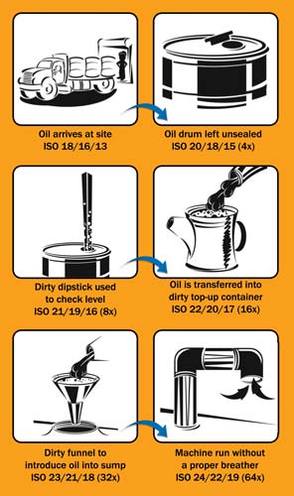 3. New Oil Receiving Oftentimes, improper receiving techniques do nothing but promote higher risks of contamination ingression, mixing of lubricants, etc. Proper written receiving procedures should be in place to ensure the highest level of consistency and cleanliness is maintained. Proper receiving techniques should include filtration of incoming oils. Many times new oils may be dirtier than your defined particle target cleanliness level. Meaning, if you define your particle target cleanliness level and spend time, money, manpower, etc., to achieve these levels of in-service lubricant cleanliness, the last thing you want to do is contaminate it with “dirty” new oils. 4. Quality Control Quality control of lubricants delivered from lube suppliers must be verified to ensure the correct product is being delivered and that the cleanliness of the delivered lubricant are up to current target particle and moisture cleanliness levels. To help ensure your lubricants are meeting their standards, the use of oil analysis is a powerful tool and will reveal the following: - Quality of base stocks
- Additive quality and concentration
- Lubricant performance properties
- Thickener performance properties (grease)
5. Presence of Mixed or Contaminated Lubricants Oil analysis results and other quality assurance variables, such as damaged containers, rusted containers and any other quality issue, should be well documented and cataloged. Items to note in the documentation phase are: - Delivery date and date of oil sample taken
- Inspection results of storage containers
- Labels depicting results of oil analysis test
- Itemized checklist for sampling test
- Periodic decontamination with filtration
Whichever storage container is chosen, it is best to filter the new oil while filling the storage container. Doing so will reduce the amount of contamination that is delivered with the new oil, but periodic filtration and agitation should be performed to maintain certain ISO cleanliness levels and prevent additive settling. Periodic filtration is a good practice to ensure clean, fresh oil will be used to perform top-ups and drain and fills. There are two primary methods for filtration of bulk stored oils: hard plumbed filtration system or filter cart. The hard plumbed filtration system works best in conjunction with a rack mounted system. Each container should be fitted with a breather, sight glass, filter, lubricant label, quick connect fittings and dedicated dispensing line. This system will help ensure the lubricants are at optimal condition when they are needed and the right product for the application is dispensed. Periodic filtration for drum storage also is easy with the use of a filter cart once the drums are equipped with quick couplers. No matter how large or small the storage container, periodic decontamination should be a priority to maintain the quality of the stored lubricant. 6. Dispensing Options for Stored Oils When stored oil is transferred from the bulk storage system to the top-up container, it is best to filter the dispensing oil. This can be made very easy with the use of a hard plumbed filtration system and a rack mounted storage system fitted with dedicated dispensing nozzles. If using 55-gallon drums, they can be fitted with quick connect fittings, a hand pump, an inline filter manifold breather and sight glass to achieve the same goal. Improper dispensing of new oils into top-up containers is a primary cause of self-induced contamination. Proper techniques and tools must be used to ensure your new, filtered oil is transferred to the top-up container with minimal exposure to atmospheric conditions. Not using proper techniques here could be a waste of time to the filtration efforts, storage and in-service lubriation cleanliness. (by Stephen Sumerlin) to be continue...
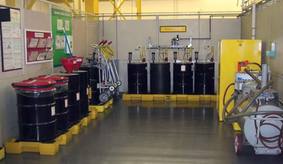 For a complete and proper lubrication program to work effectively and provide the most return on investment, the entire gamut of lubrication must be considered, ranging from receiving to application. Through this gamut there are missed opportunities to increase equipment productivity and reliability and to maximize the returns of investing in a professionally designed lubrication program. One of the biggest and most costly missed opportunities is proper lubricant storage and handling. Many facilities are unaware of the danger improper lubricant storage and handling practices create and what inevitable fate it can lead to in terms of equipment reliability and lifecycles. Proper lubrication is not only about the right amount-at the right time-at the right place, it is also about keeping lubricants clean, cool and properly identified. Here are some tips to help outline the best practices for proper lubrication storage and handling: 1. Lube Room Design and Requirements A properly designed lube room must be functional, safe and expandable, and provide all necessary storage and handling requirements for the facility. Lube room designs should allow the maximum storage capacity without allowing for too much bulk oil and grease storage. Limiting the amount of bulk oil and grease storage will allow the oils that are stored to be used in a timely manner. Some key features to consider are a limited access door, which will allow for logging of who and when a lube technician enters and leaves the room; visible landing area for new lubricants; log all new lubricant deliveries; make filtration of stored lubricants easy; provide proper safety devices; designate enough floor space for fire proof storage cabinets to store top-up containers, grease guns, etc.; and include a desk and computer to track inventory, sampling, filtration, receiving, etc. It also is a smart idea to have a separate storage area to store bulk totes, drums, buckets, etc. 2. Bulk Oil Storage The first area of a lubricant storage and handling system that requires attention is bulk storage. Whether storing lubricants in a 10,000-gallon tank or 55-gallon drums, it is very important to ensure the lubricants’ quality is not tainted by contamination or additive settling. To help ensure lubricants stay in an optimal condition, one must determine how much lubricant should be stored at one time. To aid in this process, certain steps can be employed, such as: - Determine lubricant consumption rate. Consumption will vary greatly depending on industry and equipment type. To ensure the right quantities of lubricants are being stored at a facility, the consumption rate must be determined. There are many factors that contribute to consumption, ranging from leaks to excessive drain and fills.
- Determine lubricant storage capacity. The required lubricant storage capacity depends on consumption, but often there are too little or too many lubricants stored at one time. The proper storage capacity should maximize shelf life but allow for a certain percent excess of critical lubricants to be stored for emergency situations.
- Determine lubricant supplier turnaround time. A lubricant supplier’s turnaround time should be a metric used to aid in determining the quantity of lubricants stored. If there is a short time interval between deliveries, fewer lubricants can be stored onsite, but if there is a lengthy time interval between deliveries, the quantity of lubricants stored onsite should account for this.
Once the consumption rate and storage capacity have been determined, one should decide what type of storage containers will be used. The correct size storage container is a direct reflection of the consumption rate and storage capacity. If a large consumption rate is determined, a large bulk storage tank may yield the best results, but if a low consumption rate is determined, a rack mounted storage system or 55-gallon drums may yield the best results. For smaller facilities that have a small consumption rate, the use of drum storage may be the best option (by Stephen Sumerlin) To be continue...
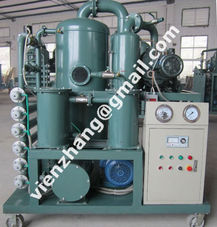 "Our oil analysis results often show levels of water present in the oil. We are considering the purchase of portable equipment suitable for the removal of water from lube and hydraulic oil systems. I have also been told by some people that some separators can only remove water down to the water saturation level of the oil. Is there a preferred method for removing water from oil in a lube or hydraulic circulating system? How much water can be removed by these methods?"Water in any lubrication system is bad news. In hydraulic systems, it can result in vaporous pump cavitation, corrosion and valve stiction, while in circulating lube oil systems it can cause oil film strength loss, rusting and other serious mechanical problems. The effects of water on the oil are often overlooked. Excessive water contamination can result in premature oil oxidation and promote the buildup of sludge and varnish. In ester-based fluids, it can result in the hydrolytic destruction of the base fluid resulting in the formation of corrosive acids. In some circumstances, water can also strip additives from the oil through water washing or hydrolysis resulting in premature oil degradation. For these reasons, the best strategy when it comes to water is to monitor and control the root cause of the water ingression. This can be achieved by ensuring that all seal and breathers are in good shape (consider using desiccant style breathers), lube tank hatches are closed and sealed properly and that top-up oil is stored and handled properly. Water can exist in three phases in an oil, free, emulsified and dissolved. Free and emulsified water cause the most damage so a good rule of thumb is to keep moisture levels below the saturation point so that all the water is in the dissolved state. For typical mineral-based industrial oils, this is typically 200-300 ppm. The most effective way of achieving this is to use a vacuum dehydration unit. These systems are capable of removing free and emulsified water as well as up to 70-80% of the dissolved water. For a typical hydraulic fluid, this can mean water levels as low as 30-50 ppm (0.003-0.005%). Alternatively, many companies are reporting success with vapor extraction devices mounting on tank tops. Some of these devices work similar to air conditioners in removing humid air from tank headspaces.
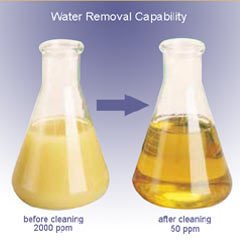 There are several jobs that the lube oil is designed to perform. Lubrication of moving parts, cooling, cleaning, corrosion control, and etc. The oil companies work diligently to produce oils to meet engine manufacture's ever increasing requirements, creating better and better oils each year. Over the years, using vastly improved oils, the engine manufacture's have increased their recommended oil drain intervals for their engines, but we are still draining the oil on a routine basis. When most maintenance personnel are asked, "why does one have to change the oil?" Their answer is usually one of the following: "Because it breaks down" or " Because it wears out."
The concept that oil "breaks down" or "wears out" is not correct. Just look at what has happened over the past fifteen years, in regards to oil drain intervals. Fifteen years ago, typical recommended oil drain intervals for a 300 horsepower H.D. diesel was around 8,000 to 10,000 miles in an over the road truck. Today, the same trucks typically have 425 to 450 horsepower engines, yet the oil drain intervals have increased to 15,000 to 25,000 miles. The same quality crude oil base stocks that were used 15 years ago are used to make oils of today. So why does the same oil today last twice as long as it did fifteen years ago? The answer can be found within the additive package of today's oil. The petroleum base of oil lube does not wear out, rather it is the additives within the oil that become depleted, due to the presence of contamination. Therefore, it makes common and technical sense that if one could remove these contaminants, we could then run the oil for a longer period of time, but for how long?
New Engines - New Problem:
One of the major contaminants facing the new oils of today is Soot contamination. Soot is a four letter word to diesel engines. In recent years engine manufacturers have had to develop engines to meet EPA emission standards. Therefore, contamination that once was "Going Up In Smoke," is remaining in our engines and winding up in the lube oil. These newer engines emit less contamination through the exhaust, therefore higher carbon soot levels are being detected within the engine. Several SAE papers have shown how Soot contributes to diesel engine wear. One of these papers points out just how severe the problem of Soot in today's engines is. According to COMO paper EX1, Soot will enter the lubrication oil at the rate of .0048 oz for every gallon of fuel burned. A truck will burn 1,786 gallons of fuel every 12,500 miles, at 7 mpg. During this 12,500 mile interval, more than half a pound (8.75oz) of Soot will enter the oil.
The majority of Soot particles generated within the engine are 10 microns or SMALLER. Most engines are only equipped with full flow filters that, at best, remove and control particles 15 microns and LARGER. Full flow filters are now designed to protect the engine from large particles that could damage vital parts. These filters must be porous enough to allow high flow rates of oil to the engine for lubrication of parts. The typical flow rate for a full flow filter within a diesel engine is 15 to 20 quarts per minute. Therefore, they are not designed to remove small contamination. Full flow filters do little to control Soot contamination within the oil.
Soot & The Next Millennium:
This problem of Soot contamination in today's engines will soon become a larger problem by the year 2004. EPA emission requirements for the year 2004 will force the diesel industry to deal with a three letter word, EGR (exhaust gas re-circulation). In March 1998, at API's Lubricants Committee meeting in San Francisco , as reported in "Lubes & Greases" magazine (May '98), John Graham of Cummins Engine Co. had the following comments about the impact of EGR on diesel: "Diesel engine manufacturers face the prospect of having to REDUCE their drain interval recommendations significantly because of increasing levels of Soot, caused by the need to introduce EGR." In an effort to reduce nitrogen oxide (NOx) emissions in the year 2004, it will be necessary to incorporate EGR for diesel engines. EGR exhaust is cooled and re-circulated though the engine in order to reduce oxygen concentrations within the cylinder thereby lowering flame temperature and nitrogen oxide (NOx). Soot and fuel sulfur oxides are critical issues with EGR. In his opinion, Graham noted a dramatic decrease in oil change intervals to, say, around 10,000 miles would be needed. Instead of trying to solve this problem of higher Soot levels by adding additional filtration, the engine manufacturers and oil companies are relying on those "NEW" oils to solve this problem and if the oil companies can come up with new oils to contend with EGR Soot, the only option will be to shorten oil drain intervals, or is this the only option?
There is a very common sense approach to the dilemma facing the engine and oil manufacturers. Soot is not a gas or liquid, it is a solid particulate. One can greatly extend present routine lube oil drains by installing additional depth type by-pass filters. The By-Pass Oil Filter only filters about 10% of the oil each minute through a very dense element. It does not supply the engine with oil for the purpose of lubrication. Its sole purpose is to clean the oil. By-Pass filters can control the higher levels of Soot and other solid Contamination within today's engines, as well as ones into the future, without the need to go to a higher tech oil.
Other than Soot , there are several other types of contamination that must be dealt with in order to extend lube oil drains. In order to greatly extend and/or eliminate the process of routine oil drains one must install additional filtration and establish the proper service intervals for these filters to deal with contamination missed by the full-flow filters and other types of contamination generated within the engine.
There are three basic types of contamination that must be dealt with: "Solid", "Moisture" and "Condition Caused" contamination. The following information will fully explain these types of contamination and how additional By-Pass filtration will effectively control these areas.
Soot and Other Solid Contamination: It is generally recognized, backed by numerous tests and studies over the last 40 years, that contamination generated in an engine that is responsible for the majority of "normal" wear, is within the 1 - 15 micron range. Also this small solid contamination contributes to accelerating Condition Caused Contaminants such as Oxidation, Nitration, Acid formation and more. Consequently, it is imperative that this contamination be removed from the system as fast as possible. The typical factory full-flow filter cannot control 1-15 micron particles due its porous design to supply the engine with a high flow rate of oil. One must use UF filtration that is capable of controlling solids in the 1-15 micron ranger and smaller.
Moisture Contamination: Moisture contamination within the lube oil will cause viscosity increase, VI polymer decrease, TBN decrease, acid formation, accelerated sludge formation, and corrosion of parts. To safely eliminate routine oil drains, one must use additional filtration that utilizes an adsorbent filter media which can remove suspended moisture from the lube oil.
Condition Caused Contamination: There are three MAJOR Condition Caused Contaminations that are formed within the lube oil during normal use: Oxidation, Nitration, and Acid. These contaminants are formed when solid and moisture contamination are present, and certain operating conditions exist within the engine. These Condition Caused Contaminants can be controlled by the use of additional filtration and adding new make-up oil at the service of the UF by-pass filter.
There are three basic types of contamination that must be dealt with: “Solid”, “Moisture” and “Condition Caused” Contamination. The following information will fully explain these types of contamination and how adding additional By-Pass filtration will effectively control these areas.
a) Oxidation: Oxidation occurs when the hydrocarbon constituents (and other products) of lube oil combined chemically with oxygen. Lube oil in engines will combine with available oxygen under certain conditions to form a wide variety of oxidation products. Many of these direct or primary oxidation products combine with other materials such as wear metals, solid contamination, and moisture, to form second and third derivative products. As with most chemical reactions, oil oxidation is accelerated by heat and pressure. Heat in particular will speed up the oxidation process. Various studies have shown that lube oxidation (with many variables such as the type lubricant and additive package in the lubricant) that the oxidation rate can be doubled for every 15 to 20 degrees increase over 180 degrees F. Also, engine load, which will dictate the levels of oxygen and pressure within the engine can be seen in the form of accelerated acid formation, corrosion, oil thickening, deposit formation, and accelerated wear.
All top quality lube oils have an additive package that contains oxidation inhibitors to slow the oxidation process and alkaline detergents that will neutralize acids formed by oxidation. Normally these additives will only last a certain length of time before they are depleted and the oil must be drained. GCF, Inc. has established the correct means by which to control oxidation within engines. As we have seen, oxidation is greatly stimulated by the contamination solids and moisture. Solids tend to hold heat, thereby increasing the lube oil temperature around the solid contamination. This condition acts to accelerate oxidation. Combine this effect with the presence of moisture (H2O) from normal condensation, and the oxidation process accelerates even faster. When moisture is present in the lubrication system, the level of oxygen available to mix with hydrocarbons in the lube oil is raised dramatically. The presence of normal solid and moisture contamination, combined with maximum operating load of the equipment, will produce high oil oxidation rates, even with normal oil temperatures. In order to control the oxidation process, the GCF PM Program recommends By-Pass filtration products that can control the levels of moisture, wear metals and other solid contamination. By removing this contamination, the oil will offer a better seal between the rings and liners and therefore reduce the amount of blow-by during the combustion process. Blow-by contributes to the amount of oxygen and moisture within the engine.
Once we have removed the contamination which acts as catalyst to accelerate the oxidation process and have offered a cleaner oil to seal the engine, then we are left with MINIMAL OXIDATION for the additive package of the oil to contend with. The engine will use a certain amount of oil each operating day. Combine this amount of new oil with the amount added at the time the By-Pass Filter is serviced, and the engine will maintain a sufficient amount of active additives to keep oxidation in check indefinitely.
b) Nitration: The combustion chambers of engines provide one of the few environments where there is sufficient heat and pressure to break the atmospheric nitrogen molecule down to two atoms that can react with oxygen to form nitrous oxides (NOx). When nitrogen oxide products enter the lube oil through normal blow-by, they react with moisture present in the lube and become very acidic and rapidly accelerate the oxidation rate of the oil. Proper By-Pass Filters can control the effects of nitration in the same ways it controls oxidation. By delivering cleaner oil to offer as a seal between the ring and liner, blow-by of NOx components are kept to a minimum. Also, the GCF Filter keeps the oil chemically dry and prevents the mixing of NOx and moisture, which controls NOx acid formation and accelerated oxidation of the oil.
c) Acid Formation: Acids are formed within the lube by several sources. We have already covered two of them in the form of acids formed from oxidation and nitration. In most all forms of fuel for internal combustion engines, trace amounts of sulfur are present. Sulfuric acid is formed within the lube oil when sulfur molecules react with oxygen in the combustion chamber to form sulfur oxides. These sulfur oxides are then blown past the rings and enter the oil. Here the sulfur oxides mix with moisture to form the highly corrosive sulfuric acid. It is next to impossible to remove trace amounts of sulfur from fuels by filtration. However, it takes two components to make the sulfuric acid, sulfur oxides and water. By using UF By-Pass filters that utilize absorbent type filter media, such as cellulose (paper) or cotton, the TBN (Total Base Number) of the oil stays up and the TAN (Total Acid Number) remains low.
After taking a look at all of the types of contamination and the effects they can have on an engine if left unchecked, I think that you can now see why the use of UF By-Pass filters is so important. When using these filters, one can remove and control contamination within the engine. Once this contamination is removed from the system, lube oil drain intervals can be greatly extended.
After understand above facts, we recomend our TYA vacuum lube oil purifier machine, which can solve the oil "wear out" problem, it is more economical compare with replacing new lube oil, because oil cost is higher everyday.
|











 RSS Feed
RSS Feed


